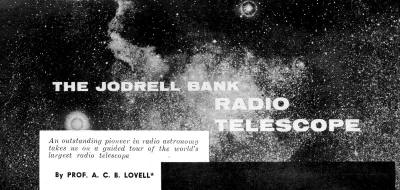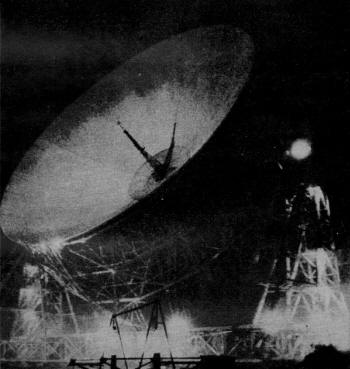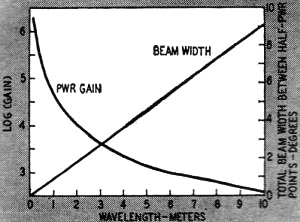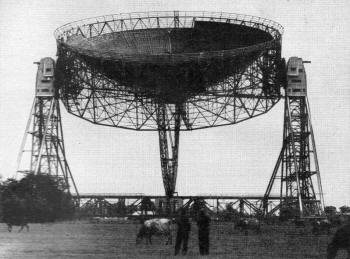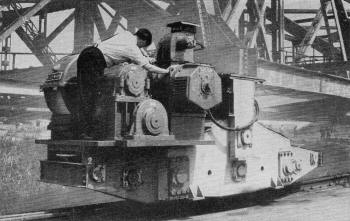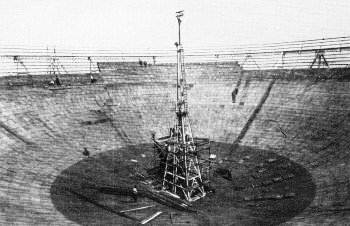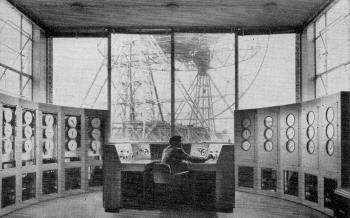The Jodrell Bank Radio Telescope |
|||||||
Radio astronomy has been the motivation for much research work in the design of low noise, high sensitivity receivers, but also in determining the characteristics of the Earth's upper atmosphere. Before sounding rockets could be launched to verify theoretical proposals, observed versus predicted behavior in radio signals being reflected off the moon and planets needed to be explained and, if necessary, corrected. One notable example of atmospheric perturbation is the rotation of polarization caused by electrons in the ionosphere (the Faraday effect). Parametric and cryogenically cooled receiver front end technology has been primarily driven by the needs of radio astronomy. The International Geophysical Year (IGY), launching (literally) a coordinated multinational effort to more fully understand the upper atmosphere's effects on communications, began the same year this story appeared in Radio-Electronics magazine. While it is true that radio astronomy has the advantage of not needing to wait for clear, dark skies to be useful the way observation in visible wavelengths does, it does suffer from its own very large list of handicaps to which classical visual observations are oblivious. The Jodrell Bank Radio Telescope An outstanding pioneer in radio astronomy takes us on a guided tour of the world's largest radio telescope By Prof. A. C. B. Lovell*
The telescope is essentially a paraboloidal steel bowl 250 feet in diameter, with its focus in the aperture plane (straight up from the center), built so it can be directed toward any part of the sky. The total weight above ground of the moving structure is 2,000 tons. In principle the motion of the telescope is alt-azimuth (vertical and horizontal). The bowl, which weighs about 700 tons, is driven vertically by a Ward-Leonard speed-control drive system through two 27-foot racks from the dismantled battleship Royal Sovereign. These are mounted 170 feet above ground on two towers which rotate on a 350-foot circular railroad track to provide horizontal movement. The drive is through two bogies (see photo) under each tower, again through a Ward-Leonard system. Four additional bogies, which are not powered, serve as wind carriages on each side of the structure. The towers are connected near ground level through a heavy pivot which is the fundamental locating part of the telescope. Power and instrument cables come through this central pivot into a motor room situated within the diametral girder immediately above the central pivot. This room contains the motor generator sets and controls for the Ward-Leonard systems. The 17-foot double-gauge railroad track on which the telescope rotates is mounted on deep-piled foundations which extend 90-feet underground in some places. The various power, control and instrument cables are taken into an annular laboratory below the central pivot and then through an underground tunnel to the control room. This control room houses the main control racks and console. The computer system consists of synchro resolvers (which resolve vectors into two mutually perpendicular components) working in servo loop to solve the necessary equations so the telescope can track a star's movement.
A wide range of movements can be selected at the control desk - for example, automatic sidereal (star tracking motion at a given right ascension and declination, motion in galactic latitude and longitude, straightforward motion in azimuth and elevation, and various automatic scanning movements with a choice of rasters. Parallax corrections can also be introduced when it is desired to track a body in the solar system. There are no slip rings so that the danger of creating electrical interference is avoided, and the limit of motion is 420°, after which an automatic reversal takes place. The telescope has a tracking accuracy of at least 12 minutes of arc at speeds up to 4° per minute. The maximum slewing speed is about 22° per minute in azimuth and elevation. The position of the telescope in azimuth and elevation is repeated back to the control room through synchros driven independently of the driving system by accurately machined chain racks. These positions are repeated to an accuracy of ±1 minute of arc. The Reflector The reflecting membrane is of 1/12-inch-thick steel sheet. It is made from 7,000 individual 3 x 3-foot sections welded to the purlins of the steel framework. It was essential to insure good conductivity across these welded sections, otherwise the membrane would become very lossy at certain wavelengths. The primary antenna feed is carried at the focus on a steel tower built 62-1/2 feet up from the parabaloid's apex. The tower's cross-section diminishes rapidly with height to avoid obscuration and scattering from the primary feed. However, it was essential to design it with enough stiffness to avoid displacement as the bowl turns over. An important scientific requirement is easy access to the primary feed so that the operational wavelength can be changed readily. The aerial is mounted in a 50-foot steel tube which slides into the top of the aerial tower. With the bowl inverted it can be brought down to ground level and replaced by another 50-foot tube complete with aerial system. The radio-frequency cables from the aerial run inside this tube and can be reached from a small platform near the base of the tower when the bowl is facing toward the zenith.
In much of the work the radio-frequency preamplifiers and other parts of the receiving equipment must be mounted as close as possible to the aerial. These essential units will be kept in a small laboratory which swings underneath the bowl. Further laboratory space is available at the tops of the two towers, but even from these the minimum length of cable run to the primary feed is about 200 feet. Other scientific apparatus will be installed on the base girders, but the main recording apparatus will be in laboratories adjacent to the control room. In preliminary tests, the smoothness of the motion of the telescope in azimuth and elevation has exceeded all expectations, and the power loading has been a small fraction of that available. The theoretical curves showing the beam width and power gain as a function of wavelength are shown in the diagram. On the frequencies used (90 and 160 mc) the experimental values for the beam width and power gain have agreed well with these calculations. Further preliminary tests on frequencies of 408 and 1420 mc are now in progress. Distortions in the bowl are not believed to exceed about 1 inch relative to the focus and very good performance, even on the important hydrogen-line frequency of 1420 mc, is anticipated. The telescope is adaptable for use either as a receiver for the galactic and extragalactic radio emissions or as a transmitter and receiver for the investigation by radar of meteors and other bodies in the solar system. Some of the tasks for which it will be used follow. The pioneer observations of Jansky, and later of Reber, showed that the intensity of the radio emission varied markedly with the direction of the aerial beam, being most intense from the direction of the galactic center***. The variation was generally what might be expected if the stars in the Milky Way were responsible for the emission. However, neither Jansky, Reber nor any subsequent worker has succeeded in detecting radio emissions from any of the stars (other than the sun), nor have the localized radio sources since identified coincided with any typical common star. It is possible that Reber's original suggestion, that the radiation is emitted by the interstellar gas, is at least partially true, but the situation is very complex and the question of the origin of these galactic radio emissions will form a prominent part in the program of the new telescope. Localized Radio Sources
When some of the radiation from space was discovered emanating from localized radio sources, it was tempting to conclude that the background continuum was made up of large numbers of these discrete radio sources, unresolved by the available radio techniques. This situation would be analogous to that in which the Milky Way is viewed by eye or through a low-power telescope, when all faint stars appear as a continuum of light and only the brightest stars stand out individually. It is now known that this view of the radio emission is untenable. Not only have improved techniques failed to reveal the increased number of appropriately distributed sources, but the spectra of the background and the sources are not compatible. About 15 or 20 of the localized sources of radio emission satisfy the various criteria, such as appreciable angular extent, intensity and distribution, which makes it highly probable that they are members of the local galaxy. Seven of these have been satisfactorily identified with galactic objects. For example, the radio source in Taurus, which is the third most intense in the sky, is associated with the Crab nebula. The Crab nebula is the expanding gaseous shell of the supernova of 1054 AD. Its distance is about 4,000 light years, and the angular dimensions of both the telescopic and radio object are about 4 x 6 minutes of arc. The temperature of the gaseous shell, which is expanding at the rate of about 70 million miles per day, is 50,000°K, which is far too low to produce the observed radio intensity of 1.8 x 10-23 watt/m2 per cycle per second (at 80 mc) by thermal processes. It is possible that the radio emission can be explained as a synchrotron** mechanism resulting from the movement of high-energy electrons in weak magnetic fields. It now seems highly probable that supernovae like the Crab nebula are both powerful radio emitters and responsible for the generation of an appreciable fraction of cosmic rays. There are two other well-attested cases of supernovae in the galaxy, those observed by Tycho Brahe in 1572 and by Kepler in 1604. Unlike the Crab nebula, these are not spectacular objects. Even so there seems little doubt that radio sources are associated with them.
The result of this search was the surprising discovery that this powerful radio emitter consists of a very faint extended nebulosity of a type previously unknown. The gaseous filaments of this nebulosity are in violent motion at thousands of kilometers per second. There is no satisfactory explanation of the mechanism of the generation of radio waves nor is there any agreement as to the nature of the object itself, although opinions have been expressed that it may be the remains of a very old supernova. Radio Sources There are only three other agreed identifications of radio sources with galactic objects. These are the Cygnus loop and the nebulosities in Auriga and Gemini. These are all extended gaseous nebulosities of low photographic brightness, with filamentary structure. As with the Cassiopeia source, there is no agreed opinion as to their nature or that of the mechanism whereby they emit radio waves. The only general conclusion which be drawn from the present situation is that the galactic radio sources appear to represent a very rare type of celestial object characterized by an appreciable extension of diffuse gas of low photographic brightness. Whether they are different manifestations of the same phenomena (supernovae) or vary in character remains uncertain. Attempts have been made to associate the radio sources with other rare classes of galactic objects such as novae, planetary nebulae and globular clusters, but without success. The new telescope, with its high definition and adaptability over a wide frequency range, is expected to be a powerful tool in the investigation of the problem of these galactic sources and of the continuum. Initially it is hoped to make measurements at a few selected points in the frequency range of 20-1,400 mc to study the isophotes (lines of equal brightness) of the continuum and the spectra of the localized sources. At present, surveys in England and Australia have revealed between 2,000 and 3,000 localized radio sources. Apart from the galactic concentration of a small number of the intense and extended sources discussed above, these sources are distributed isotropically (identically in all places) and are probably extragalactic. A relatively small number have been identified with telescopic objects such as the Andromeda nebula and other similar nebulae, but it seems likely that the majority of these are quite abnormal and at very great distances. For example, the second most intense radio source in the sky lies in Cygnus, and this has been identified as two galaxies in collision at a distance of 200 million light years. The existence of this intense radio source (1.4 X 10-22 watt/m2 per cycle per second at 80 mc) associated with a celestial collision nearly at the limit of penetration of the 200-inch telescope is one of the most remarkable features of radio astronomy, with far-reaching cosmological implications. During the last few years a further half dozen or so radio sources associated with unusual extragalactic objects have been discovered. These include NGC1275 in the Perseus cluster and a source in Hydra, which Baade and Minkowski consider may be galaxies in collision. Other peculiar associations include NGC5128, which has a dark and across it, and M87 from which a jet emanates.
In a collision of galaxies the stars are too widely separated for significant collisions to occur, but the dust and gas, which represent an appreciable fraction of the galactic mass, will certainly suffer real collisions at velocities of, perhaps, thousands of kilometers per second. The key to the mechanism that generates the radio waves probably lies in this highly agitated ionized gas. The collection of further data on both the normal and abnormal radio sources is essential to understanding the problem of the extragalactic radio emissions. The new telescope is well fitted to pursue this important task over a wide range of wavelengths. Transmits too The preceding examples of the new telescope's uses have all concerned the programs in which the instrument will be used as a receiving aerial. There are many problems in which it will be used as a combined transmitting and receiving aerial. (It ha been used, for example, for tracking artificial satellites and their attendant rocket sections. - Editor) In these radar or radio-echo aspects of the work, the moon and the planets will figure prominently. Radio echoes from the moon were first claimed to have been observed in 1946 by Z. Bay in Hungary. His recording system was unusual, and the first certain echoes obtained in the conventional sense on a cathode-ray tube were by the U. S. Army Signal Corps. Subsequently echoes were obtained by Kerr and Shain in Australia. These experiments showed that the moon echoes were subject to deep and rapid fading - an effect which is now believed to be due to a peculiarity of the moon's motion with respect to the earth, known as libration. During this period, apparatus for lunar-echo studies was also under development at Jodrell Bank, and it appears that this is the only systematic investigation of the moon by the radio-echo technique which has yet been carried through. This apparatus works on a frequency of 120 mc and uses a transmitter giving 10 kw in 30-msec pulses at a recurrence rate of 0.6 per second. The receiver bandwidth is 30 cycles, and appropriate arrangements have to be made to allow for Doppler shift in the frequency of the returned signal. The most important results obtained with this apparatus concern the long-period fading (20 to 30 minutes), which by cross-polarization experiments has been shown to be due to the rotation of the plane of polarization of the radio wave as it traverses the ionosphere (the Faraday effect). This immediately led to developing a moon-echo system by which the ionosphere's total electron content could be determined. The technical difficulties in this work are considerable and, with the present aerial system, measurements can be made only with the moon in transit for about 10 periods in each lunation. The new telescope will immediately remove these handicaps and will enable systematic data to be collected about the total ionospheric electron content. This is bound to be of considerable importance to our understanding of the ionosphere and of solar-terrestrial relationships. The problem of radio echoes from the planets is vastly more difficult and, as far as is known, no serious attempts have yet been made to solve it. The magnitude of the problem relative to the moon is indicated by the fact that success in detecting radio echoes from Venus would demand an overall power sensitivity between 1 and 10 million times greater than that required in the case of the moon. This assumes, of course, that the reflection coefficient of the planet would not be inferior to that of the moon.
The problem has been carefully considered at Jodrell Bank in relation to the very great gain of the new telescope, and an attempt to obtain planetary echoes will be made early in the research schedule. The complete return journey of the earth-Venus radio signal will take 4 minutes and success in detecting such a radio echo would be a spectacular technical accomplishment. Nevertheless, the experiment could not be justified on this basis, and it is hoped that with the telescope a systematic program will be possible in which the rotation period can be determined and information obtained about the Venusian surface and atmosphere. The telescope will also be used to study very faint meteors and the aurora borealis by the radar technique. As a receiver it will be applied to many other problems such as the radio emissions from the sun and the planets. In all these programs the great power gain coupled with the adaptability and ease of steering of the telescope is confidently expected to give results of outstanding interest as well as importance.
* Director of the Jodrell Bank Experimental Station, University of Manchester. ** A device for accelerating electrons or protons in a circular orbit in an increasing magnet field by applying an alternating electric field in synchronism with the orbital motion. At sufficiently high speeds polarized light and, it is believed, polarized radiation, some in the radio spectrum, is produced. The polarization is in the direction of motion. *** Radio Astronomy. Lovell and Clegg. Radio Astronomy, Pawsey and Bracewell. The Changing Universe, Pfeiffer.
Posted April 11, 2022 |
|||||||

